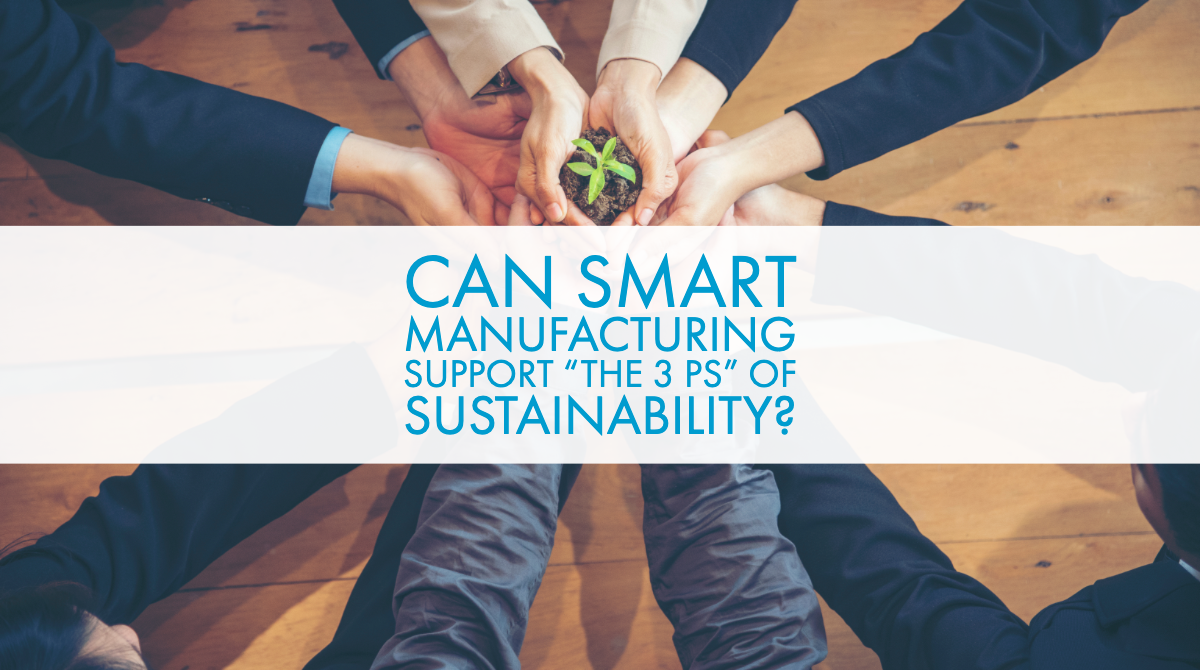When was the last time you heard the phrase smart manufacturing? Yesterday? Two hours ago? In one of our recent posts? What about the word sustainability? Although these terms are likely heard multiple times a day, what do they really mean, and how do they intersect? What can smart manufacturing contribute to the industry's sustainability?
The most commonly used definition of sustainability is development that meets the needs of the present without compromising the ability of future generations to meet their own needs. It concerns ecological, human and economic health -- sometimes referred to as planet, people and profits.
Smart manufacturing involves fully-integrated, collaborative systems that respond in real-time to meet the changing demands and conditions in the factory, in the supply network, and in customer needs. It is using technology to solve existing and future problems at an ever-increasing speed. So how can a fully-integrated, collaborative system meet today’s needs without compromising the needs of the future? How can smart manufacturing support the sustainability of the 3Ps -- planet, people, and profits?
Profits
Some of the biggest challenges facing manufacturers next year go beyond the usual “reduce costs and improve performance” mantras. They have long-term impacts on sustainability:
- Supply Chain Visibility
- Labor Pool Shortage
- Trade
Underlying these challenges is the need for faster adoption of smart manufacturing to ensure profitability.
Supply Chain Visibility
Being able to see the entire supply chain means being able to see every detail in real-time. Data from the factory floor and third-party vendors provides a clearer picture of what impacts delivery to the end-user. Looking at real-time data enables companies to make data-driven decisions when problems arise. They no longer have to wait for the data to be collected, synthesized, and then analyzed. Problems are corrected sooner rather than later.
Another part of supply chain visibility is the customers' demand for transparency. They want to understand the product lifecycle and its impact on delivery. They want to know how a company’s processes contribute to environmental and social sustainability. And they want answers to those questions immediately.
Using smart manufacturing, companies deploy technology to collect data throughout the supply chain, making it easier to see problems before they happen. That means taking steps to correct the issue before it becomes visible to the end-user.
Labor Shortage
Deloitte conducted a manufacturing perception study in 2017. They noted that less than three in ten Americans would encourage their children to pursue a career in manufacturing. Yet, manufacturing has the highest demand for workers in any market sector in the United States.
As the existing labor pool ages out, fewer workers are entering the manufacturing sector. Many of those entering the workforce lack the skills needed to use the technology of smart manufacturing. It is estimated that of the 3.5 million manufacturing jobs needed through 2025, two million will go unfilled because of a lack of skills. Smart manufacturing can deploy technologies to compensate for a shrinking labor pool. It can also facilitate the training of employees hired to replace those leaving the workforce.
Trade
How can smart manufacturing help with global events that are outside of a company's control? It can help build in the flexibility needed to source and sell globally. Current geopolitical pressures affect nearly every industry sector, and manufacturing is no exception. They must consider changes to the supply chain and be prepared to implement them quickly should the need arise. Being prepared for possible disruptions in the supply chain as a result of trade is vital to a company's sustainability heading into the 2020s.
Smart Manufacturing
Smart manufacturing can go beyond improved efficiency and increased productivity to more sustainable benefits such as supply chain transparency and visibility. It can compensate for the labor shortage and increase the knowledge base of a younger workforce so that growth can be maintained. It can even prepare a company to address disruptive factors that are beyond its control.
Planet
In a recent survey, 66 percent of surveyed manufacturers said sustainability was crucial to being competitive in the industrial space. Improving sustainability has become a priority not only because of cost savings but also because of public concern for the environment. Companies are using smart manufacturing to help find ways to improve environmental sustainability.
Ericsson initiated a process to find sustainability in smart manufacturing. The company developed an approach that balanced the complexities of technology, manufacturing, and environmental sustainability as part of its analysis. Ericsson gained an in-depth understanding of how its processes worked. The company was able to develop use cases to show how to reduce energy consumption and transportation costs, which lowered emissions.
When companies reduce waste and emissions, they reduce the impact manufacturing has on the environment. Smart manufacturing gives companies the option to look at data over the long term to find trends and identify areas where programs can be designed to reduce the environmental impact.
People
Smart manufacturing enables companies to become economically sustainable, which in turn sustains its people through improvement in wages, benefits, and working conditions. However, ensuring that people remain a sustainable resource requires a broader view of sustainability. Take, for example, the current labor shortage that has become one of the industry's most considerable challenges. A survey was conducted in 2014 to identify what companies perceived to be the issues regarding an aging workforce. The following were the typical responses:
- “Our aging workforce clearly impacts essential capabilities - we know what specific skills are at risk.”
- “The critical skill shortages we face have no connection to the aging workforce.”
- “We expect the aging workforce to be a problem, but we don’t know what skills are at risk.”
- “We have no idea if the aging workforce is a problem and we’re unaware of any looming skills gaps.”
Although most companies would agree that the aging workforce poses problems, many are still trying to decide how to bridge the gap. Smart manufacturing can do more than just improve profitability. It can provide the knowledge that is missing as the aging workforce walks out the door. What is missing is the mechanism to turn that knowledge into actionable insights that will sustain an effective and productive workforce.
A well-designed knowledge management platform works alongside smart manufacturing to build a system to train and enable a sustainable workforce. Why not contact us to learn more about how to create a sustainable workforce?






Leave a comment